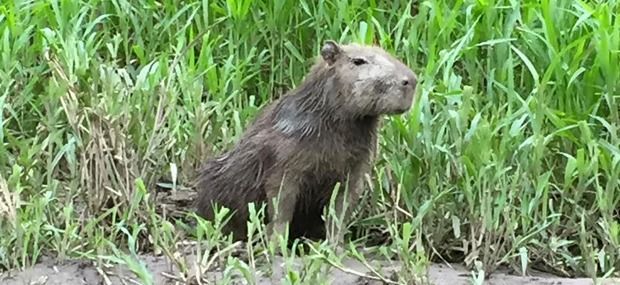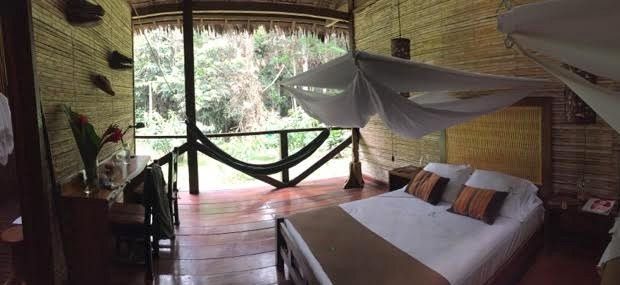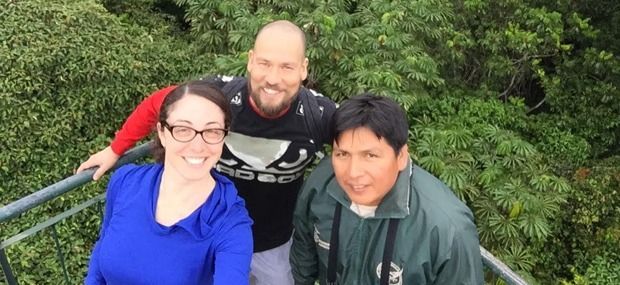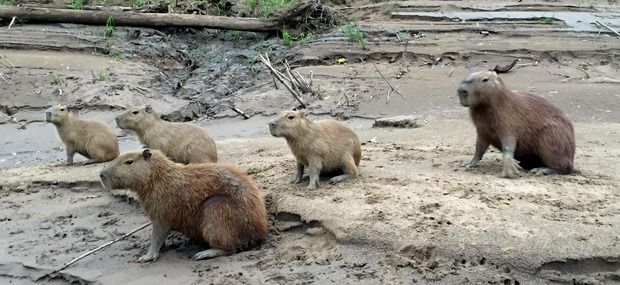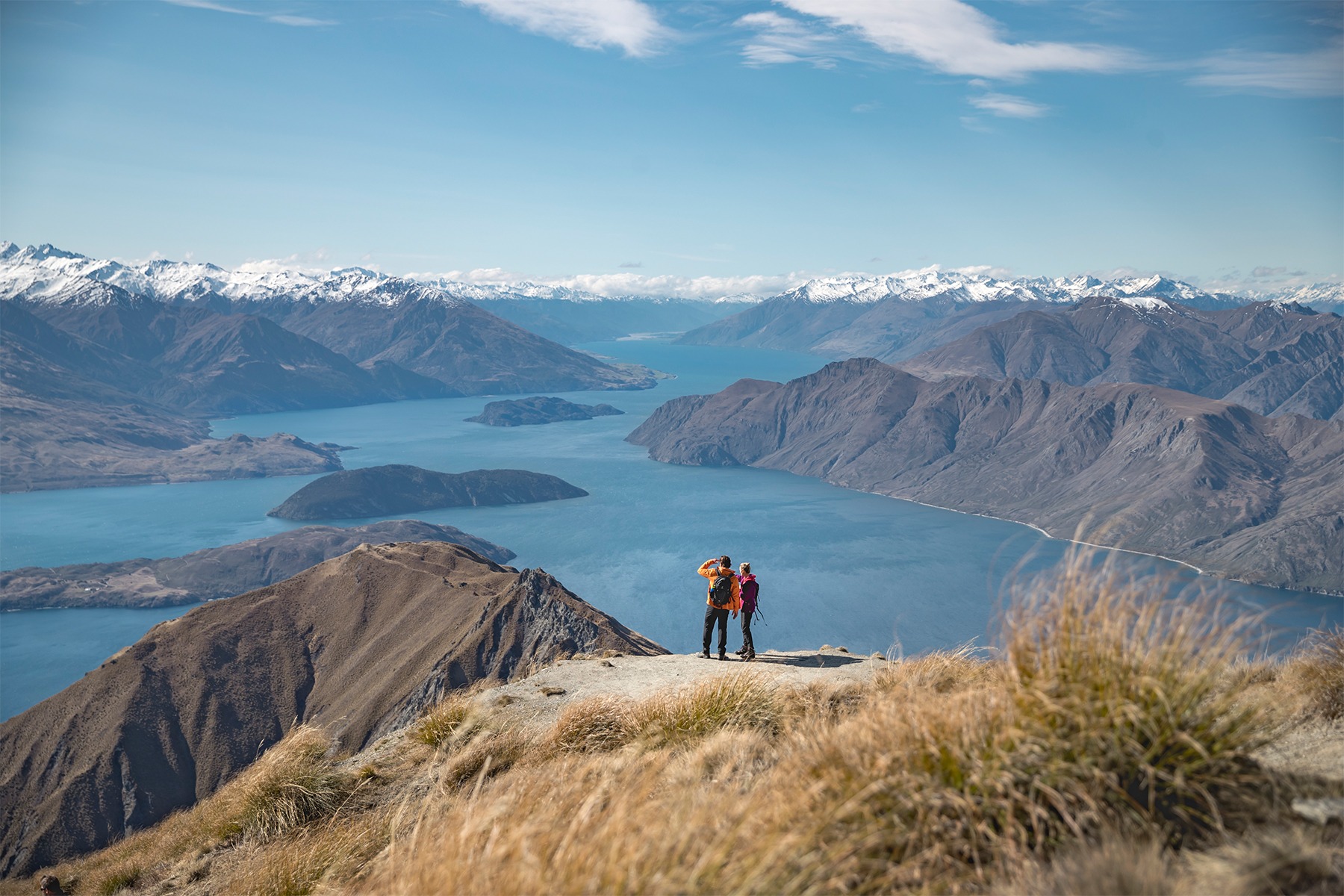By Mirko Seminario
Flying almost two hours via Cusco from Lima, we arrived in Puerto Maldonado. After meeting with our guide Cesar, we had a brief stop at the Rainforest Expeditions offices where we were offered refreshments to cool down from the heat and humidity. We were also given the opportunity to separate our luggage so we only took what we needed for the three days at the lodge. After a 45 minute drive, we arrived at the port located in the community of Infierno. (Along the way we received delicious snacks to tie us over until lunch).
Embarking the wooden canoe like boats we made the three hour journey up the river. During the boat ride we were served a typical lunch of fried rice and vegetables that was wrapped in a leaf which served as our plate. During the journey our guide was on the look out for animals. Fortunately we saw the rare sight of a capybara family the large rodent who lives near the river banks. We had the opportunity to get up close to the banks and take great photos and videos. Before getting to the lodge, we stopped at the checkpoint for a few minutes where our guides register the number of people entering the National Park; from here it only takes 35 minutes to get to the lodge.
Arriving at our destination we climbed a set of wooden stairs and walked 20 minutes through the trees experiencing the sights, smells and loud noises of the jungle for the first time to Refugio Amazonas lodge. Open to the elements Refugio Amazonas has a two story main house made from natural materials of timber and leaves.
The lodge had just been redesigned with modern furniture and had all the modern cons, which you wouldn’t expect in the middle of the jungle (electricity, Wi-Fi -until 10pm just in superior and premium rooms- and hot water to name a few). The main house has two chill out areas with very comfortable seating, a bar which serves a large variety of local wine and beers and also has an extensive cocktail menu.
As part of the main house there is also the dining area which has long social tables and serves buffet style breakfast, lunch and dinner all meals are included in the price of your stay and the kitchen caters for vegetarians.
The lodge has three types of rooms available Classic, Superior and Premium. All rooms are separated from the main house and are accessible by raised boardwalks which are lit in the evenings. Rooms have three bamboo walls with one wall completely open and exposed to the elements and the jungle. Michelle and I stayed in the superior room, which was very spacious with two double beds (insect nets included) a hammock to enjoy the jungle view and ensuite bathroom with eco-friendly toiletries.
Whilst at dinner the friendly staff prepare your room for the evening by dropping the insect net over your bed and adding a blanket if it is going to be a cold night. Most nights there is a lecture from one of the local guides. We attended a talk on Caymans which was fitting because at nightfall we walked back to the river to search for them. We boarded a boat with a spotlight so the guide could search for them.
In complete silence we glided along the calm river in the darkness with the spotlight as our only source of light. We were lucky to see a few baby Caymans. They were very active moving about on the banks and swimming in the river. That night with the bed covered by the insect net we heard some animals rustling in the jungle close to the room, it was very dark and quiet except for the animal noises. At dawn the natural light woke us up and to our surprise, we heard rain falling and the jungle relatively quiet compared to when we arrived.
After breakfast we set out with our guide for a morning hike through the jungle. Since it had been raining most of the night we wore gumboots supplied by the lodge. It was a good idea as there were many large muddy areas along the track. Early into the hike we saw a snake which our guide told us was one of deadliest snakes in the world.
It was green in colour and settled on a small leaf of a tree right on the edge of the walking track. This was a reminder to keep our eyes and ears open while walking through the jungle as you never know what animals dangerous are close by.
Walking deeper into the jungle the noises became louder with birds calling from the tree tops. Cesar our guide advised that the birds were making the calls as a warning to others that we were in there area. Along the walking track we witnessed hundreds of thousands of leaf cutter ants and soldiers hard at work. Most of the ants were not carrying any leaves, however on the way back to the lodge we saw them carrying cut leaves back to the nest.
After a few hours we arrived at a 30 metre tower, which took us up to the tree canopy, we climbed to the top and from here we saw a curl crested aracari and many more birds. It was lucky that Cesar was a keen bird watcher and spotted many birds hidden on branches. After a while we headed back down to under the tree tops and made our way to Lago Condenado, close to the lake our guide stopped and looked up into the tree canopy, he pointed at some rustling leaves there was a brown titi monkey looking back at us. We soon spotted more of the monkey family and watched them swing from branch to branch.
Once we arrived at the lake our guide took a canoe from the bank and paddled us around Lago Condenado. Our guide continued to talk about the surrounding fauna and flora, he pointed out white wing swallows and the hoatzin Bird. The Hoatzin bird has claws under its wings so if it falls in to the water which is full of Cayman and piranhas as a chick it can climb up the tree to safety.
We were also told how the lake formed from very wet monsoon seasons followed by years those that are not as wet. The lake eventually starts to grow plants and begins to get taken off by trees and turns back into rainforest.
On the other side of the lake Cesar pointed out the walking palm which has raised roots which move to get the most light and rain. Soon it was time to start the trek back to the lodge. Passing the busy leaf cutter ants still hard at work we were on the lookout for more animals. Further along the trail we spotted brown capuchin monkeys swinging through the tree canopies. One inquisitive monkey with a baby on its back had a great time looking down at us from the canopy while other played around her. Nearing the lodge we saw a brown agouti on our walking path. The Agouti eats Brazil nuts so at times are seen close to the lodge were there are many.
Back at the lodge We had time to freshen up before lunch. After lunch we were scheduled to go to a clay leak and also a night walk, however due to the rain both were cancelled so instead we had a good time relaxing in the hammock in our room, enjoyed a few drinks at the bar and met other travellers. That night there was another talk this time given by a visiting researcher on birds.
The next day it was an early start to make the journey back to Puerto Maldonado. We got to take in the river for one last time. As it was raining we did not see any other animals however it was a good time to look at the pictures we had taken and reflect on the great experiences we were lucky to have.
Due to family commitments in Lima we could only stay two nights and three days but I highly recommend a minimum three nights and four days or combining your stay at Refugio Amazonas with a stay at Tambopata Research Centre (five and a half hours away from Refugio Amazonas).
Tambopata Research Centre is an excellent place to stay for in depth explorations of Amazonian nature and wildlife. One of its many attractions includes the world’s largest known macaw clay lick, over twenty five identified macaw nesting sites, primates and other larger mammals, and a high bird diversity.
If you want to find out more about the destinations in this article, or have any questions in general please contact us.

